Want to score big on opening day? Have a game plan. Donald M. Jones
Opening day of deer season can be chaotic in most of whitetail country. There are more hunters in the woods on this day than at any other point during the season. All that commotion pushes deer out of their regular patterns. Because of this, shooting a mature buck on opener can feel like a matter of luck. Sometimes it is.
But there are also some key tips and tactics you can use to have more success on the first day of the season. So, her are our 20 best deer hunting tips for opening day.
TIP 1: SIT THE HOT SEAT
Dawn of the gun-season opener may seem like controlled chaos to you, but deer begin to react to hunter movement even before the first shot is fired. When the shooting does start, they’ll be on the move. That’s what makes your stand selection so critical.
Escape routes and feed-to-bed trails may be your best bet. Deer that were on a food source during the night will beat a hasty retreat for thick cover once dawn arrives. Select your stand accordingly.
TIP 2: GET TO BED
Most deer, when pressured, are going to head for home. They’ll seek out those thick, nasty areas where they feel safe and secure. And that’s where you must be waiting.
How to Hunt It: Position your stand—an elevated a treestand is the way to go—on the outer edge of the best cover available in your hunting area. The key is to place the stand so that you have good visibility but are very near the thick tangle that deer are heading for. Edges are natural routes of travel for whitetails, and the added visibility will increase your effective shooting range. It’s critical to get into position long before first shooting light.
TIP 3: PINPOINT THE PINCH POINTS
Not long after first light—when the guns get to cracking—deer will be seriously on the move. They’ll do it quickly and efficiently. That means they’re going to follow the path of least resistance, so pinch points and funnels located in cover can be dynamite on opening day.
How to Hunt It: Locate your stand downwind of a prime terrain feature that will focus deer movement. Pack a lunch and stay put. When the pressure is on, you could see a shooter buck at any time of the day, either moving naturally (especially if the rut is on) or as a result of being bumped by neighboring hunters. Stay alert.
TIP 4: GET LOST
It’s an old adage, but sometimes you have to hunt where no one else is willing to go. A recent Penn State study of radio-collared deer showed that whitetails change their patterns almost immediately on the day before the general firearms season opener due to increased human traffic.
How to Hunt It: Go for broke and hunt an out-of-the-way location few others would consider. Small, obscure pockets of cover produce some of the biggest bucks each season. They may not look like much, but they are overlooked sanctuaries. A small ditch, a tiny ravine, a patch of grass in the middle of an open field. Hide and sit out the day.
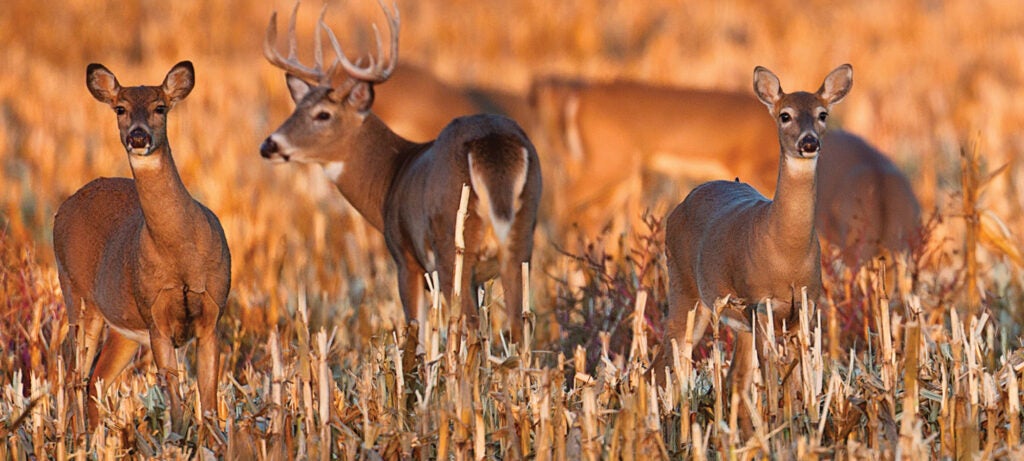
Have a game plan to score on opening day. Lance Krueger
TIP 5: LET THE WEATHER BE YOUR GUIDE
Food-source abundance, hunting pressure, the influence of the rut, and the moon will all affect the action on opening day. Nothing, however, will impact the timing of when you’ll see that action more than the weather. Most of us are deer-season weather watchers, but you’d better pull your best Al Roker if you want to get it exactly right.
High Pressure
What to look out for: A whirling mass of cool, dry air that generally brings fair weather and light winds.
How to Hunt It: This is what everyone plans for—seasonable temperatures, little to no wind, sunny days, clear nights. When the forecast calls for a stationary high-pressure influence, park your butt on stand or in a blind and sit it out.
The Wildcard Tactic: If temperatures are subfreezing, hold off switching locations until after the sun has melted the morning’s frost.
Heavy Wind
What to Look out For: Wind speeds over 20 mph. Know that there’s much more to whitetail hunting as it relates to wind than simply trying to stay downwind of a buck. Essentially, there are two different key factors to heed: wind direction and speed.
How to Hunt It: The stronger the wind speed, the quicker the barometric pressure will rise, and the time to be out is after it subsides—especially if the wind changes from east to west.
The Wildcard Tactic: This can be prime time to still-hunt or plan a drive.
Rain
What to Look out For: The lilting sound of droplets hitting the roof of deer camp. Rain on opening morning means more to hunters than it does to the deer. Precipitation will do little to slow down deer movement.
How to Hunt It: Grab your raingear. Bucks can neither hear you nor smell you. It’s a great time to go for a serious still-hunt.
The Wildcard Tactic: Wait out a deluge in a covered blind or watch the radar back at camp. When the tailing edge is an hour away, hit the woods.
Snow
What to Look out For: Your local weather forecaster predicting a snowmageddon.
How to Hunt It: Whether it’s a heavy snowfall or just flurries, snow makes deer hunting easier. Unless there’s a raging wind, you’ll be able to see animals better and, as with rain, they won’t be able to hear or smell you as well. Sit in a stand if you prefer, but snow is made for tracking.
The Wildcard Tactic: The two hours prior to and the two hours just after are the absolute best times to hunt a snowstorm.
Heat
What to Look out For: Daytime highs above 70 degrees.
How to Hunt It: Whether it’s opening day or the peak of the rut, you’d almost be better off rescheduling—but, of course, you can’t. Whatever you do, don’t miss first and last light.
The Wildcard Tactic: Post in a stand near a water hole.
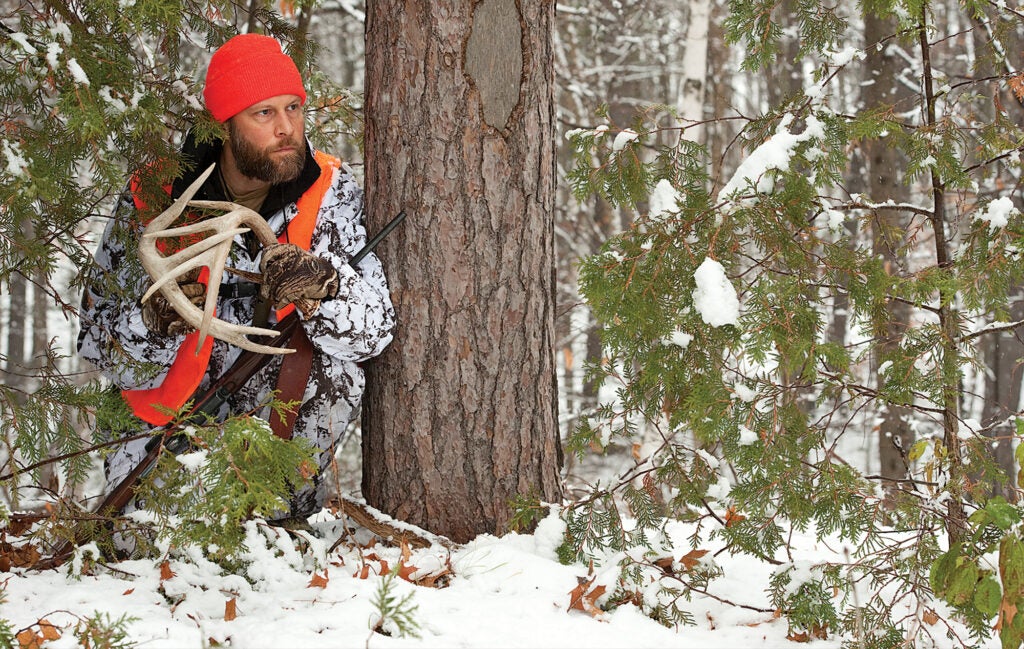
Observe the weather and make your opening day plans accordingly. Mark Raycroft
TIP 6: MAKE A CHARCOAL MASK
The point of wearing face paint isn’t to provide interesting selfie fodder—it’s to keep deer from seeing your shiny mug.
Greasy paints are a pain in the butt and difficult to remove. Charcoal is a simple but cheap alternative. Grab a briquette (avoid the quick-lighting kind) out of the bag next to your grill. Place it in a plastic bag and use a hammer to pulverize it into powder. Now you have face camo that’s a cinch to apply, washes off easily, and has the added benefit of providing some level of scent control (carbon is, after all, the key ingredient used in scent-eating clothing).
TIP 7: SWEETEN THE PLOT
Ed Spinazzola is a Michigan legend renowned for his pioneering methods of food plotting. One of his favorite concepts is devilishly simple: Make the forage you’re hunting more attractive than any other in the area. This is done with fertilizers and a basic understanding of plant biology.
About two weeks prior to opening day, hit the forage you plan to hunt with a dose of urea (46-0-0 fertilizer). Follow that up with an application of nitrogen. The urea will fuel the root system and the nitrogen will turn the foliage ultra-green. This only works on plants that are still green, of course. Doing this to soybeans makes them seem almost neon in color, and deer will pound them.
This sweetening process works on native vegetation as well. If state law allows it, you can do this sweetening process on public lands and existing natural browse.
TIP 8: ZIP IT UP
Always keep a stash of zip ties in your pack. You can use these slivers of plastic magic to quickly affix your tag to a deer, erect a ground blind, or add cover to a stand.
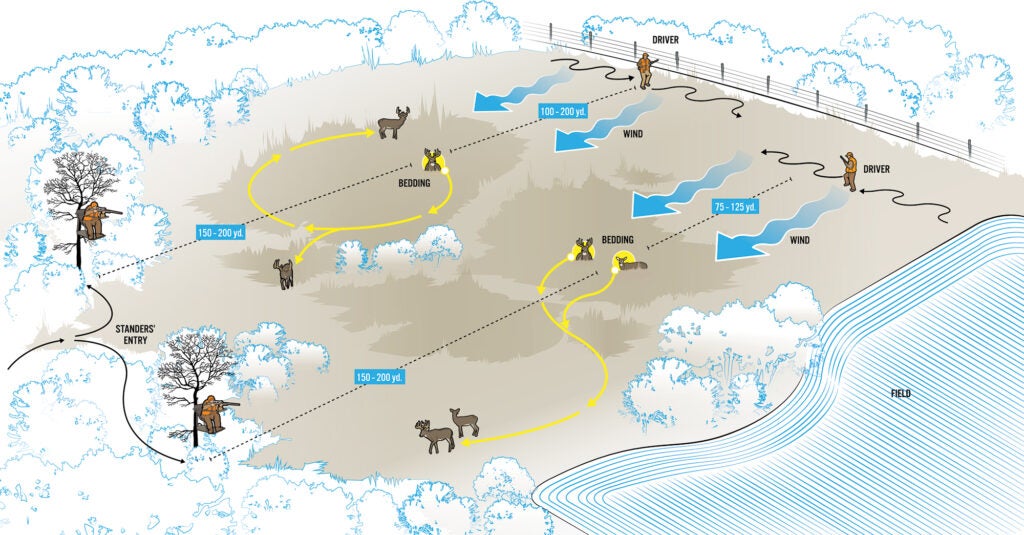
A well-orchestrated drive can produce big results on opening day. Ryan Kirby
TIP 9: DRIVE ‘EM HOME
If you intend to do your own drive, learn from the mistakes of others. On the opener, a small group (see illustration at right) can produce better results than a big one. With so many hunters out, the goal isn’t to push deer but rather to nudge them into positions you can take advantage of.
Start with a small group—three to five hunters—and position a pair of standers on the downwind side of cover at least an hour before the drivers begin to work.
Once standers are in place, drivers drift along the upwind sides of deer-holding cover, moving slowly and quietly. The goal is to allow scent to sift into the cover, getting deer on their feet and sneaking away.
This does two things: First, it affords the standers shots at deer that are walking rather than running. Second, the drivers can often catch deer that are circling to identify the threat and eventually return right back to the cover they just left—something older bucks do more often than you’d think.

If you hunt an area where drives are popular, you can cash in by playing the overlooked escape routes. Ryan Kirby
TIP 10: LET THEIR DRIVE WORK FOR YOU
Deer drives may be controversial in some circles, but there’s little argument as to their effectiveness with regard to getting deer on their feet. An opening day drive can work if it’s done right—and you can also benefit from drives gone wrong on neighboring property by hanging a stand off the property line.
Many drives are done with too many hunters and too little planning, which means deer are up and moving long before standers or drivers are in place and subtle escape routes are overlooked. It’s those escape destinations that you want to target.
In farm country with small woodlots (above), brushy fencerows serve as travel corridors. Take that into account.
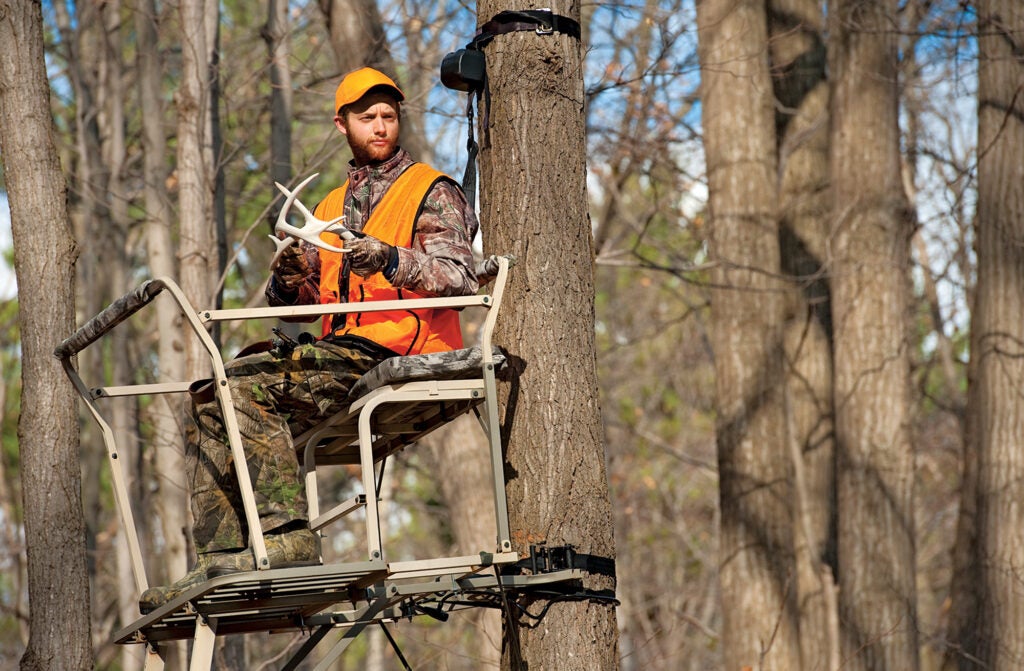
The primary goal on opening day: Be where the deer will be. Mark Raycroft
TIP 11: DON’T KILL YOUR HOTSPOTS
There should be one single goal when the sun rises on opening day: Be where the deer are. There is but one way to give yourself the very best odds of doing just that. You have to scout for whitetail deer—but you have to do it correctly. Gun season will bring out more hunters than all of bow season in most places, and, like most of us, they’ve not had enough time to properly do it.
They hit the woods with gusto just days, or hours, before the new season dawns. They prep their blinds, clear shooting lanes, freshen up attractants. And they move deer. Don’t be one of those guys. Your scouting efforts should intensify as the season draws near, but your level of impact while in-season scouting should decrease.
TIP 12: USE YOUR EYES
Long-range surveillance can work wonders in areas of open ground. Even though it’s gun season, this oft-used bowhunting tactic shines here. Jeff Danker, host of Major League Bowhunter, is one of the best observational hunters I’ve ever met. His lesson is worth heeding if you hunt open country.
“I’m not going in to kill a buck until I know I can actually kill it,” he says. “I’ll spend as much time as it takes just watching and observing from a distance. I want to learn that deer. Once I feel like I know what it’s doing, then I’ll move in.”
If you live in an area where cover is thick, like much of the Midwest and South, trail cameras can do the work for you. But check those cameras sparingly and carefully. Remember, as the season draws near, more and more hunters are going to be in the woods trying to find their own hot seat. That pressure will put deer on alert.
TIP 13: PHONE HOME
The use of trail cameras that send images remotely is slightly controversial, but it is undoubtedly effective for monitoring deer activity without stinking up the area you intend to hunt. Moultrie’s new Mobile system uses an external modem to send images directly to your computer or smartphone using an LTE cellular network. These units allow you to access highly relevant data right up to (and during) the opener without applying undue human pressure in the woods.
TIP 14: BUDDY-FREE LOADING
You’ve just killed an opening-day buck and need it loaded into the truck. Your buddies are hunting. So what are
you to do?
Easy. Grab a pulley, a pair of stout ropes, and a hunk of plywood or a couple of wide boards. That’s all you need to load that deer by yourself.
First, take a rope and thread it through the tiedowns toward the front of your truck bed. Rig the pulley eye through the rope and locate it roughly in the center of the bed.
Now, run a rope through the pulley. Tie off one end on the deer (around the neck for does, antlers for bucks) and the other end around a stout tree or fence post. With the planks, create a ramp from the tailgate to the ground and position the deer so that it will slide up the ramp and into the truck.
That’s it. Put the truck in gear and slowly pull forward. The deer will slide into the bed of the truck and you’ll have conquered the task without having to call in a single favor.
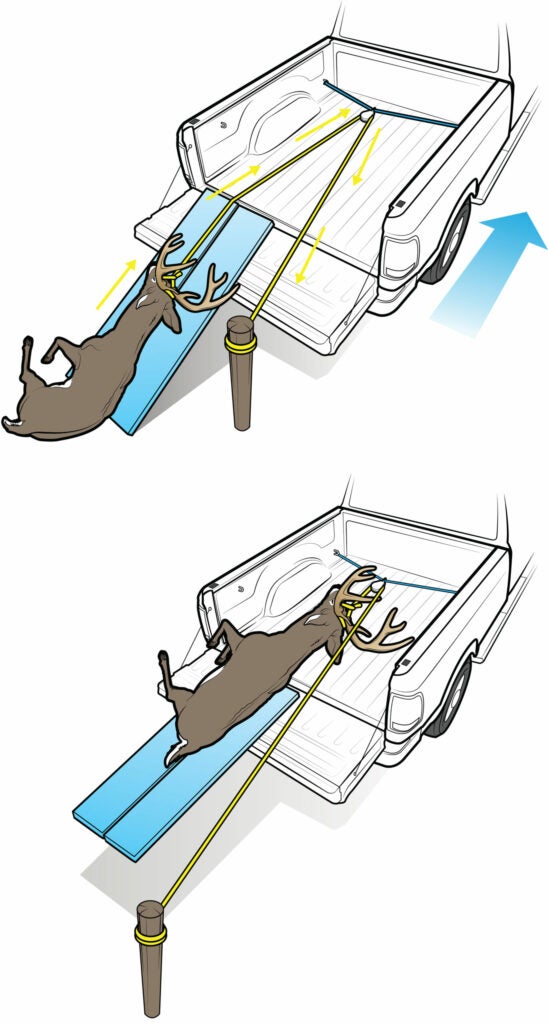
Self-loading: Load a deer on your own with this great tip. Ryan Kirby
TIP 14: HEADS OR TAILS
It is a debate as old as the rope in your granddad’s barn: Do you hang a deer head-up or head-down?
A head-high hang shows off antlers best and allows for easier gutting if you didn’t field dress the deer. But a head-down orientation makes butchering a whole lot easier and choice cuts more easily accessed. It might also allow meat to cool a bit faster.
Because I like to rinse my skinned deer with clean, cold water, I prefer the heads-up position. It seems to make that chore a bit quicker and more efficient.
Hanging the buck by its hind legs is said to eliminate any excessive stretching of the cape, though I’ve not seen any evidence of the stretched-neck syndrome.
TIP 15: SIT ALL DAY
This is a simple one, but it can be tough to follow. Plan to hunt all day. If your opener falls during the rut, daytime movement can be even better than early mornings or evenings. Plus there will be commotion from other hunters moving about the woods and heading back for lunch. Wear warm gear, bring plenty of food, pack a book if you must, but stay on stand or in your blind from dark till dark.
TIP 16: PUT THE “SMART” IN YOUR SMARTPHONE
A smartphone can be one of your most valuable assets when conducting a drive. Load up your phone with the onXmaps HUNT app and pair it with one of the company’s excellent map overlays showing private-public land boundaries and owner information. Now you not only can use the GPS system in the phone to know exactly where you are and what the cover ahead of you looks like, thanks to aerial imagery, but you’ll also know how far you are from neighboring property lines.
TIP 17: ASSESS AND REACT
The guys who consistently score on opening day are those who honestly evaluate the situation they’re hunting and behave accordingly. Are you hunting public land? Are you hunting private land that will see plenty of other hunters in the area? Are you hunting ground that’s managed and tightly controlled?
You need to take any moderate to intense hunting pressure into account. Studies have shown deer react to that pressure and will seek out areas of cover. They’ll choose locations where they can see or smell approaching danger. It doesn’t necessarily mean they will head to parts unknown.

An opening day can lead to your best opener ever. Donald M. Jones
TIP 18: TAKE THE RUT INTO ACCOUNT
The rut has a way of changing everything—or does it? While increased hunting pressure will certainly cause a change in the natural movement patterns of whitetails, it will not interfere greatly with their desire to breed, nor will it prevent breeding from taking place. Just because it’s firearms season doesn’t mean that you should neglect fresh buck sign. New rubs and scrapes will show up even when deer are in full-on survival mode. This sign can at least help point you in the right direction.
TIP 19: HUNT THE BEDROOM
Hunting a bedding area is always risky, but it’s a strategy well worth considering if your opener falls during the rut. If you are in an area with moderate to intense hunting pressure, rut-driven bucks will head to doe-bedding areas—these isolated pieces of security cover are where undercover breeding will take place.
Don’t expect to see helter-skelter chasing. Bucks will not dog does from one valley to the next. All you have to do is find the spot where the action is taking place and stay put. Be mindful to not kick deer out of these sanctuaries—they might not ever come back.
TIP 20: FOLLOW A BLOOD TRAIL GENTLY
He’s hit, but not down. Blood-trailing a wounded buck in crowded woods is a formidable experience. Push the trail too hard and you risk spooking your deer past another hunter. Don’t push it at all and you may never find it. The best advice is to assess the hit carefully before taking up the blood trail. If shots sound off in the direction that the deer fled, look for blood immediately and take up the trail if you find some. If all remains quiet, consider gathering a search committee.
The post 20 Deer Hunting Tips for Opening Day appeared first on Outdoor Life.
By: Tony Hansen
Title: 20 Deer Hunting Tips for Opening Day
Sourced From: www.outdoorlife.com/deer-hunting-tips-and-tactics-for-opening-day/
Published Date: Wed, 23 Jan 2019 07:48:49 +0000
----------------------------------------------
Did you miss our previous article...
https://manstuffnews.com/weekend-warriors/waterfowl-fall-from-the-sky-by-the-hundreds-as-lunar-eclipse-coincides-with-snowstorm-in-central-oregon
 Backyard GrillingWeekend WarriorsAdvice from DadBeard GroomingTV Shows for Guys4x4 Off-Road CarsMens FashionSports NewsAncient Archeology World NewsPrivacy PolicyTerms And Conditions
Backyard GrillingWeekend WarriorsAdvice from DadBeard GroomingTV Shows for Guys4x4 Off-Road CarsMens FashionSports NewsAncient Archeology World NewsPrivacy PolicyTerms And Conditions
